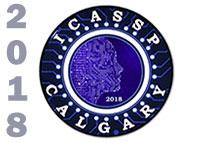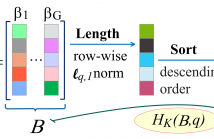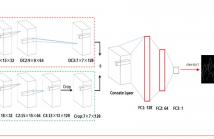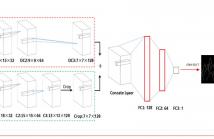
ICASSP is the world’s largest and most comprehensive technical conference focused on signal processing and its applications. The 2019 conference will feature world-class presentations by internationally renowned speakers, cutting-edge session topics and provide a fantastic opportunity to network with like-minded professionals from around the world. Visit website.

- Read more about COVER SONG IDENTIFICATION USING SONG-TO-SONG CROSS-SIMILARITY MATRIX WITH CONVOLUTIONAL NEURAL NETWORK
- Log in to post comments
In this paper, we propose a cover song identification algorithm using a convolutional neural network (CNN). We first train the CNN model to classify any non-/cover relationship, by feeding a cross-similarity matrix that is generated from a pair of songs as an input. Our main idea is to use the CNN output–the cover-probabilities of one song to all other candidate songs–as a new representation vector for measuring the distance between songs. Based on this, the present algorithm searches cover songs by applying several ranking methods: 1. sorting without using the representation vectors; 2.
- Categories:
 36 Views
36 Views
- Read more about NO-REFERENCE HDR IMAGE QUALITY ASSESSMENT METHOD BASED ON TENSOR SPACE
- Log in to post comments
- Categories:
 29 Views
29 Views
- Read more about Compressive Regularized Discriminant Analysis of High-Dimensional Data with Applications to Microarray Studies
- Log in to post comments
We propose a modification of linear discriminant analysis, referred to as compressive regularized discriminant analysis (CRDA), for analysis of high-dimensional datasets. CRDA is specially designed for feature elimination purpose and can be used as gene selection method in microarray studies. CRDA lends ideas from ℓq,1 norm minimization algorithms in the multiple measurement vectors (MMV) model and utilizes joint-sparsity promoting hard thresholding for feature elimination.
- Categories:
 12 Views
12 Views
- Read more about SINGLE DEPTH IMAGE SUPER-RESOLUTION USING CONVOLUTIONAL NEURAL NETWORKS
- Log in to post comments
In this paper, we propose single depth image super-resolution using convolutional neural networks (CNN). We adopt CNN to acquire a high-quality edge map from the input low-resolution (LR) depth image. We use the high-quality edge map as the weight of the regularization term in a total variation (TV) model for super-resolution. First, we interpolate the LR depth image using bicubic interpolation and extract its low-quality edge map. Then, we get the high-quality edge map from the low-quality one using CNN.
- Categories:
 45 Views
45 Views
- Read more about Attention-based Dialog State Tracking for Conversational Interview Coaching
- Log in to post comments
This study proposes an approach to dialog state tracking (DST) in a conversational interview coaching system. For the interview coaching task, the semantic slots, used mostly in traditional dialog systems, are difficult to define manually. This study adopts the topic profile of the response from the interviewee as the dialog state representation. In addition, as the response generally consists of several sentences, the summary vector obtained from a long short-term memory neural network (LSTM) is likely to contain noisy information from many irrelevant sentences.
- Categories:
 12 Views
12 Views
Estimating envelope of a signal has various applications including empirical mode decomposition (EMD) in which the cubic $C^2$-spline based envelope estimation is generally used. While such functional approach can easily control smoothness of an estimated envelope, the so-called undershoot problem often occurs that violates the basic requirement of envelope. In this paper, a tangentially constrained spline with tangential points optimization is proposed for avoiding the undershoot problem while maintaining smoothness.
- Categories:
 9 Views
9 Views
- Read more about PARAMETRIC APPROXIMATION OF PIANO SOUND BASED ON KAUTZ MODEL WITH SPARSE LINEAR PREDICTION
- Log in to post comments
The piano is one of the most popular and attractive musical instruments that leads to a lot of research on it.
To synthesize the piano sound in a computer, many modeling methods have been proposed from full physical models to approximated models. The focus of this paper is on the latter, approximating piano sound by an IIR filter.
- Categories:
 12 Views
12 Views
- Read more about SINGLE DEPTH IMAGE SUPER-RESOLUTION USING CONVOLUTIONAL NEURAL NETWORKS
- Log in to post comments
In this paper, a novel framework for the single depth image superresolution is proposed. In our framework, we first extract a low-quality edge map from an interpolated depth map.Then we transform the low-quality edge map to a high quality one by our trained deep convolution neural network (CNN) with two-step postprocessing. Guided by the high-quality edge map, we finally utilize a total variation (TV) based model to upsample the initial depth map.
- Categories:
 22 Views
22 Views
- Read more about REDUCING MODEL COMPLEXITY FOR DNN BASED LARGE-SCALE AUDIO CLASSIFICATION
- Log in to post comments
- Categories:
 17 Views
17 Views
- Read more about AUTOMATIC SPEECH ASSESSMENT FOR APHASIC PATIENTS BASED ON SYLLABLE-LEVEL EMBEDDING AND SUPRA-SEGMENTAL DURATION FEATURES
- Log in to post comments
Aphasia is a type of acquired language impairment resulting from brain injury. Speech assessment is an important part of the comprehensive assessment process for aphasic patients. It is based on the acoustical and linguistic analysis of patients’ speech elicited through pre-defined story-telling tasks. This type of narrative spontaneous speech embodies multi-fold atypical characteristics related to the underlying language impairment.
- Categories:
 6 Views
6 Views